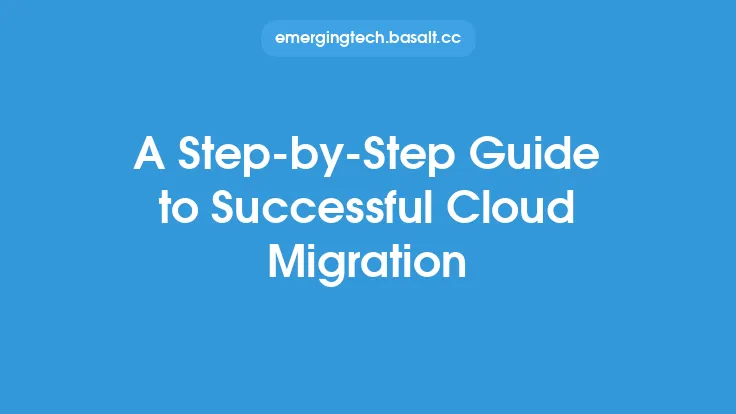Building scalable cloud applications is a crucial aspect of cloud computing, as it enables businesses to handle increased traffic, demand, and data processing without compromising performance. One of the key strategies for achieving scalability is by adopting microservices architecture and containerization. In this article, we will delve into the world of microservices and containerization, exploring their benefits, challenges, and best practices for building scalable cloud applications.
Introduction to Microservices
Microservices architecture is a design approach that structures an application as a collection of small, independent services. Each service is responsible for a specific business capability and can be developed, tested, and deployed independently. This approach allows for greater flexibility, scalability, and fault tolerance, as each service can be scaled or updated without affecting the entire application. Microservices communicate with each other using lightweight protocols and APIs, enabling loose coupling and high cohesion. By adopting microservices architecture, businesses can break down their monolithic applications into smaller, more manageable components, making it easier to maintain, update, and scale their applications.
Benefits of Microservices
The benefits of microservices architecture are numerous. Firstly, it enables scalability, as each service can be scaled independently to meet changing demand. Secondly, it improves fault tolerance, as a failure in one service does not affect the entire application. Thirdly, it allows for greater flexibility, as each service can be developed using different programming languages, frameworks, and databases. Finally, it enables faster time-to-market, as each service can be developed and deployed independently, reducing the overall development and deployment time. However, microservices architecture also introduces additional complexity, as it requires careful planning, coordination, and management of multiple services.
Containerization
Containerization is a lightweight and portable way to deploy applications. It involves packaging an application and its dependencies into a single container that can be run on any system that supports containerization, without requiring a specific environment or dependencies. Containerization provides a consistent and reliable way to deploy applications, ensuring that they run consistently across different environments. Docker is a popular containerization platform that provides a simple and efficient way to create, deploy, and manage containers. Containerization offers several benefits, including faster deployment, improved scalability, and increased efficiency.
Benefits of Containerization
The benefits of containerization are numerous. Firstly, it enables faster deployment, as containers can be spun up and down quickly, reducing the time it takes to deploy new applications or services. Secondly, it improves scalability, as containers can be easily scaled up or down to meet changing demand. Thirdly, it increases efficiency, as containers require fewer resources than traditional virtual machines, reducing the overall cost of deployment. Finally, it provides a consistent and reliable way to deploy applications, ensuring that they run consistently across different environments. However, containerization also introduces additional complexity, as it requires careful management and orchestration of containers.
Microservices and Containerization: A Perfect Combination
Microservices and containerization are a perfect combination for building scalable cloud applications. By adopting microservices architecture, businesses can break down their monolithic applications into smaller, more manageable components, making it easier to maintain, update, and scale their applications. Containerization provides a lightweight and portable way to deploy these microservices, ensuring that they run consistently across different environments. By combining microservices and containerization, businesses can achieve greater scalability, flexibility, and fault tolerance, making it easier to handle increased traffic, demand, and data processing.
Best Practices for Building Scalable Cloud Applications
To build scalable cloud applications using microservices and containerization, businesses should follow several best practices. Firstly, they should adopt a cloud-native approach, designing their applications from the ground up to take advantage of cloud computing principles. Secondly, they should use containerization platforms like Docker to deploy their microservices, ensuring that they run consistently across different environments. Thirdly, they should use orchestration tools like Kubernetes to manage and coordinate their containers, ensuring that they are properly scaled and updated. Finally, they should monitor and optimize their applications continuously, using metrics and tools to identify areas for improvement.
Challenges and Limitations
While microservices and containerization offer several benefits, they also introduce additional complexity and challenges. Firstly, they require careful planning, coordination, and management of multiple services and containers. Secondly, they introduce additional overhead, as each service and container requires its own resources and dependencies. Thirdly, they require careful monitoring and optimization, as the complexity of the system can make it difficult to identify and troubleshoot issues. Finally, they require a high degree of automation, as the scale and complexity of the system can make it difficult to manage manually.
Conclusion
Building scalable cloud applications is a crucial aspect of cloud computing, and microservices and containerization are key strategies for achieving scalability. By adopting microservices architecture and containerization, businesses can break down their monolithic applications into smaller, more manageable components, making it easier to maintain, update, and scale their applications. While microservices and containerization offer several benefits, they also introduce additional complexity and challenges. By following best practices and using the right tools and technologies, businesses can overcome these challenges and build scalable cloud applications that meet the needs of their customers.





